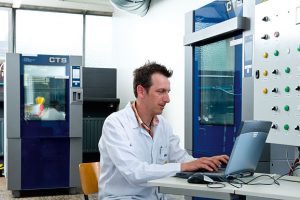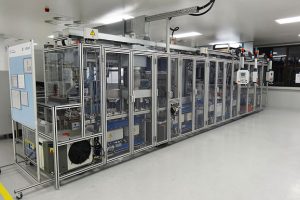Greater comfort and better fuel economy are much in demand for today’s new vehicles. Automatic start/stop systems and hybrid vehicles are good examples of developments in this direction. But in addition to the engine, it is also necessary to consider components such as the automatic transmission. In conventional vehicles, the internal combustion engine drives an oil pump that in turn builds up the necessary control pressure. When the engine is at rest, this pump also stops and the pressure drops. Newer models therefore have an electrically driven pump in the transmission to continually provide control pressure and make sure that it can change gears immediately at any time – even while the engine is not running. A robust, electronically commutated DC motor that operates reliably in the transmission oil drives this pump.

Figure 1: Robust oil pump system with excellent dynamic operation even at high oil temperatures.
Modern drive concepts for cars increasingly rely on electrically controlled operation. It allows many drive train parameters to be optimally adjusted to the current driving situation and saves energy in the process – transmissions included. Conventional, purely mechanical systems are difficult to integrate into the new concept, which is why electrically operated actuators are the means of choice. ebm-papst St. Georgen, the specialist for automotive components, now offers a robust DC motor as the hydraulic pump drive for automatic transmissions (Figure 1). It is ready to provide the control pressure required for electronic closed-loop control from a speed of zero, ideally suiting the new control and drive concept.
No more rigid coupling
In the past, only mechanically rigid coupling was possible, such as for camshaft drive via chain or gearwheel using the crankshaft. However, this principle always means a fixed ratio of speed to control time. The modern electronics in today’s cars have allowed ebm-papst St. Georgen to loosen up this rigid connection, making all the drive train control processes flexible. An advantage here is that classical hydraulic coupling or brake band activation is easy to integrate into modern transmission management via electronically actuated valves.
The dynamic internal rotor motors work at ambient temperatures from far below 0 °C to over 100 °C.
However, the classical process of pressure generation via pump – which is conventionally located on the input shaft driven by the engine – is a significant disadvantage. Pressure can only be generated when the engine is running, which means minimum delay times that become relevant during startup. And the delivery rate, which increases with pump speed, quickly becomes too high. The choke must “dispose of” the excess air flow being delivered. An elegant solution to this problem: an electrically driven auxiliary pump that provides the required pressure immediately after the ignition is turned on.
Sophisticated site of operation

Figure 2: The in-house test stand has all the equipment required for testing the motors in detail under real-world conditions.
The mechanical design of the pump depends on the individual transmission design, and the drive motor parameters must always be adjusted to the transmission. The specialists from the Black Forest solve the problem by using basic components that they select and modify according to the performance specifications. Users must observe this application’s special conditions of use: The dynamic internal rotor motors work in transmission oil and must be able to withstand ambient temperatures from far below 0 °C to over 100 °C. The oil contains additives that optimize the friction behavior of couplings, brake bands, etc. but can also have an aggressive impact on non-ferrous metals. Unprotected copper coils or unsuitable insulating enamels would corrode and fail.
Since oil is viscous in cold environments and is difficult to squeeze through cracks and openings, a low air flow is required here. This means speeds must be low and torques high, since relatively high friction must be overcome. When it is warm, oil is more fluid and the pumps must convey higher volumes. In this case, the motor must run at a higher speed and a relatively low torque. This requires a corresponding motor power curve, and here, the good field weakening capability of the drive meets the required performance profile.
Robust motors
On the one hand, different motor powers are required depending on the hydraulic design of the transmission. On the other, the existing installation space often requires extremes: a short motor with a wide diameter or the opposite (an elongated, slim motor). Motors with stack diameters of between 40 and 76 mm and differing lengths are available as basic components. They allow power, torque and design to be adjusted to user requirements. In numbers, this means that the range from 100 mNm to 2000 mNm, or converted, 40 – 500 W output power is seamlessly covered.
The motors can be produced in a special clean room to achieve the absence of dust.
Especially temperature-resistant high-performance magnets permit operating temperatures of up to 140 °C. Selected materials and varnishes are able to withstand the corrosive additives in the oil. The flexible design of the motors permits sinusoidal or block control. Despite the use of standardized motor components, of course customer-specific electrical contacts or mechanical variants, such as the integration of a pump flange into the motor bearing assembly to reduce the number of interfaces, are possible.
Production know-how
An in-house laboratory with a variety of test stands supports the development team (Figure 2). The motors can be examined in detail under the most rigorous conditions. When the development work is completed, the next step is implementation as serial production. For modern automatic transmissions in particular, the closest tolerances between moving components must be maintained. As a result, even the smallest foreign bodies can produce sensitive disruptions, damage, or even complete failure. Upon customer request, the relevant motors will be produced in a special clean room in order to achieve the required absence of dust (Figure 3). Harmonized process management and a dedicated analysis laboratory monitor production constantly in order to guarantee 100% quality assurance.
The result is modern electric motors that reliably resist the adverse conditions present in the oil baths of automatic transmissions. Optimally designed for the hydraulic issues of the corresponding transmission, they allow for reliable operation and highly responsive gear changes – even when the drive motor speed is zero. This makes them the ideal supplement to modern drive systems.


Leave a comment